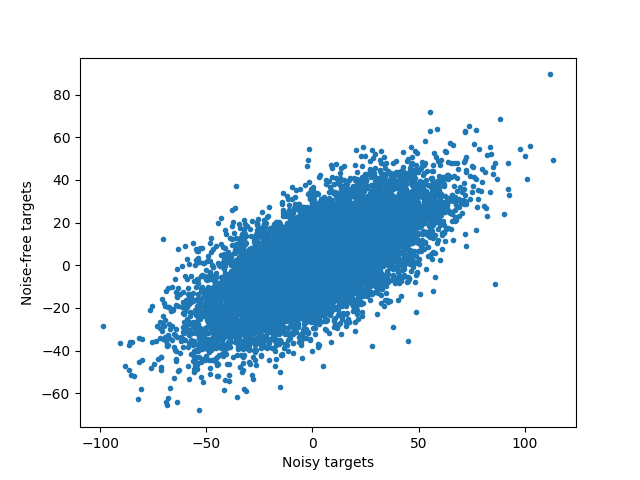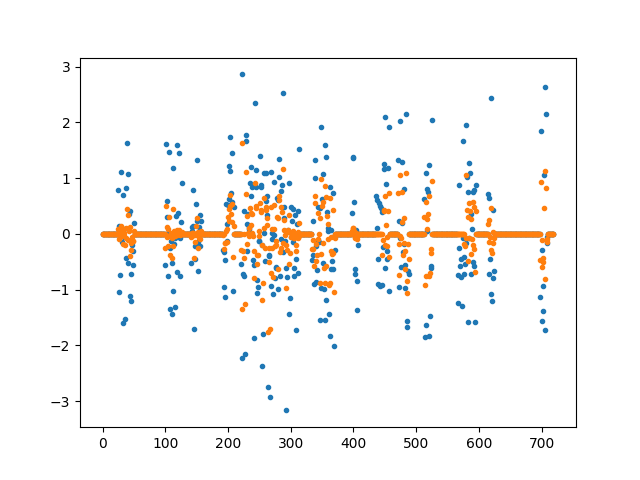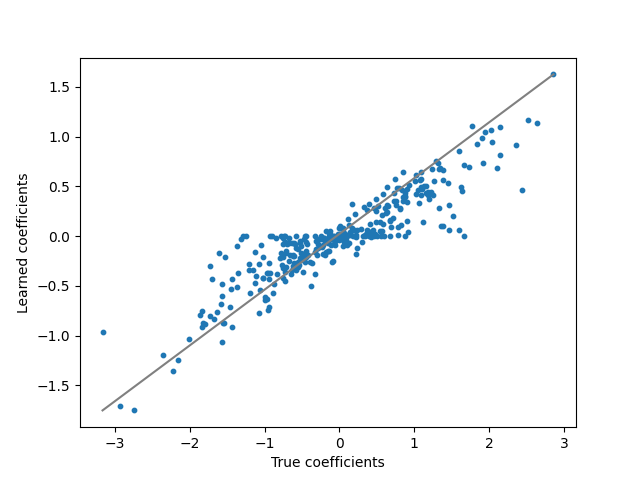Note
Click here to download the full example code
GroupLasso for linear regression¶
A sample script for group lasso regression
Setup¶
import matplotlib.pyplot as plt
import numpy as np
from sklearn.metrics import r2_score
from group_lasso import GroupLasso
np.random.seed(0)
GroupLasso.LOG_LOSSES = True
Set dataset parameters¶
group_sizes = [np.random.randint(10, 20) for i in range(50)]
active_groups = [np.random.randint(2) for _ in group_sizes]
groups = np.concatenate(
[size * [i] for i, size in enumerate(group_sizes)]
).reshape(-1, 1)
num_coeffs = sum(group_sizes)
num_datapoints = 10000
noise_std = 20
Generate data matrix¶
X = np.random.standard_normal((num_datapoints, num_coeffs))
Generate coefficients¶
w = np.concatenate(
[
np.random.standard_normal(group_size) * is_active
for group_size, is_active in zip(group_sizes, active_groups)
]
)
w = w.reshape(-1, 1)
true_coefficient_mask = w != 0
intercept = 2
Generate regression targets¶
y_true = X @ w + intercept
y = y_true + np.random.randn(*y_true.shape) * noise_std
View noisy data and compute maximum R^2¶
plt.figure()
plt.plot(y, y_true, ".")
plt.xlabel("Noisy targets")
plt.ylabel("Noise-free targets")
# Use noisy y as true because that is what we would have access
# to in a real-life setting.
R2_best = r2_score(y, y_true)

Generate estimator and train it¶
gl = GroupLasso(
groups=groups,
group_reg=5,
l1_reg=0,
frobenius_lipschitz=True,
scale_reg="inverse_group_size",
subsampling_scheme=1,
supress_warning=True,
n_iter=1000,
tol=1e-3,
)
gl.fit(X, y)
Out:
GroupLasso(frobenius_lipschitz=True, group_reg=5,
groups=array([[ 0],
[ 0],
[ 0],
[ 0],
[ 0],
[ 0],
[ 0],
[ 0],
[ 0],
[ 0],
[ 0],
[ 0],
[ 0],
[ 0],
[ 0],
[ 1],
[ 1],
[ 1],
[ 1],
[ 1],
[ 1],
[ 1],
[ 1],
[ 1],
[ 1],
[ 2],
[ 2],
[ 2],
[ 2],
[ 2],
[ 2],
[ 2],
[ 2],
[ 2],
[ 2],
[ 2],
[ 2],
[ 2],
[ 3],
[ 3],
[ 3],
[ 3],
[ 3],
[ 3],
[ 3],
[ 3],
[ 3],
[ 3],
[ 3],
[ 3],
[ 3],
[ 4],
[ 4],
[ 4],
[ 4],
[ 4],
[ 4],
[ 4],
[ 4],
[ 4],
[ 4],
[ 4],
[ 4],
[ 4],
[ 4],
[ 4],
[ 4],
[ 4],
[ 5],
[ 5],
[ 5],
[ 5],...
[46],
[46],
[46],
[46],
[46],
[46],
[46],
[46],
[46],
[46],
[47],
[47],
[47],
[47],
[47],
[47],
[47],
[47],
[47],
[47],
[47],
[47],
[47],
[47],
[47],
[47],
[47],
[48],
[48],
[48],
[48],
[48],
[48],
[48],
[48],
[48],
[48],
[48],
[48],
[49],
[49],
[49],
[49],
[49],
[49],
[49],
[49],
[49],
[49]]),
l1_reg=0, n_iter=1000, scale_reg='inverse_group_size',
subsampling_scheme=1, supress_warning=True, tol=0.001)
Extract results and compute performance metrics¶
# Extract info from estimator
yhat = gl.predict(X)
sparsity_mask = gl.sparsity_mask_
w_hat = gl.coef_
# Compute performance metrics
R2 = r2_score(y, yhat)
# Print results
print(f"Number variables: {len(sparsity_mask)}")
print(f"Number of chosen variables: {sparsity_mask.sum()}")
print(f"R^2: {R2}, best possible R^2 = {R2_best}")
Out:
Number variables: 720
Number of chosen variables: 313
R^2: 0.29097931452380443, best possible R^2 = 0.46262785225190173
Visualise regression coefficients¶
plt.figure()
plt.plot(w, ".", label="True weights")
plt.plot(w_hat, ".", label="Estimated weights")
plt.figure()
plt.plot([w.min(), w.max()], [w_hat.min(), w_hat.max()], "gray")
plt.scatter(w, w_hat, s=10)
plt.ylabel("Learned coefficients")
plt.xlabel("True coefficients")
plt.figure()
plt.plot(gl.losses_)
plt.title("Loss plot")
plt.ylabel("Mean squared error")
plt.xlabel("Iteration")
print("X shape: {X.shape}".format(X=X))
print("True intercept: {intercept}".format(intercept=intercept))
print("Estimated intercept: {intercept}".format(intercept=gl.intercept_))
plt.show()
Out:
X shape: (10000, 720)
True intercept: 2
Estimated intercept: [2.08271211]
Total running time of the script: ( 0 minutes 6.999 seconds)


